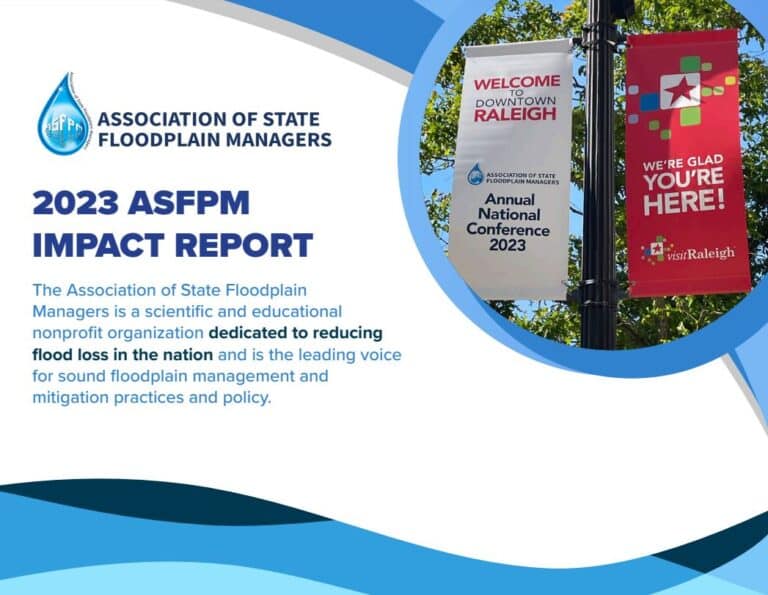ASFPM opposes House’s proposed BW-12 legislation
March 4, 2014
To: US House of Representatives
RE: OPPOSE LEGISLATION THAT THREATENS THE LONG TERM SOLVENCY OF THE NFIP, COMPLICATES AFFORDABILITY CONCERNS AND REDUCES INCENTIVES FOR RISK REDUCTION ACTIONS!
Dear Member:
The Association of State Floodplain Managers has significant concerns with HR 3370. While it is intended to address unintended consequences of the Biggert-Waters legislation of 2012, we believe that, if passed, this legislation too will have significant unintended consequences. While the bill partially addresses flood insurance affordability by extending the timeframe for phasing out Pre-FIRM subsidies (which ASFPM supports), the overall bill does much more harm than good to the program that the nation depends on in the face of our increasing flood threat.
Three reforms add substantial subsidies and financial liabilities to the NFIP which is already $24 billion in debt. First, a new cross-subsidy will be created by adding a surcharge to 100% of NFIP policies in the program to pay for the continued subsidy for the 20% of the policies that are rated as Pre-FIRM. Property owners that did their due diligence, built in compliance with local laws and standards, and reduced their risk will unfairly get assessed this surcharge.
Second, is a provision that states that FEMA shall strive to ensure that premiums do not exceed 1% of the coverage. The current, full risk rates for many structures that are built in compliance with minimum NFIP standards already exceed this threshold especially in the highest risk areas such as V-zones. The practical effect of this provision is to set a course for the NFIP that would eventually result in all policies being subsidized.
Third the proposed reimbursement for essentially all costs for appealing flood maps is a huge unknown liability for the mapping program and the National Flood Insurance Fund. We already have a severely underfunded flood mapping program. Traditionally the cost to appeal maps falls on those appealing them and many of the appeals are to add precision to a newly produced scientifically sound map. In many parts of the country, people are still having to use 30 year old paper maps and are waiting for updated maps. If this provision is enacted the funding will instead be going to reimbursing those who essentially want to purchase more precise, granular data than the FEMA mapping program can afford, yet have that program pay for it.
The legislation also permanently reinstates grandfathered subsidized rates based on existing flood maps rather than imposing higher rates based on updated mapping by repealing Section 207 of Biggert-Waters. While ASFPM sees the need to phase-in these rates more slowly than is called for in Biggert-Waters, the full repeal of this provision is sending the wrong risk message to property owners. The program can ill afford to continue in this manner, and it will give support for those who want to just eliminate the NFIP.
In 2012, 401 members of the House voted for Biggert-Waters and its underlying principles were good public policy – solvency of the NFIP, communicating true risk by pricing it correctly, and promoting good mapping and mitigation of risk. It was known that the reforms were painful but necessary. Unfortunately having no provisions to address flood insurance affordability made the task difficult and was a key element missing from Biggert-Waters. After Superstorm Sandy, thousands of property owners mitigated their flood risk by elevating their homes, floodproofing their buildings or taking other mitigation actions to make their properties safer and reduce the potential higher flood insurance rates resulting from Biggert-Waters. Early results show that Biggert-Waters is driving people to take mitigation actions and reduce risk, exactly as intended!
Fixing flood insurance affordability can be done in a targeted and thoughtful way but not by jeopardizing the entire NFIP the way that HR 3370 does, nor by unfairly charging policy holders that chose to build wisely and reduce their risk. Rather than perpetuating subsidies and future claims, we should focus our efforts in helping property owners and their communities be more resistant to flood damage which would lower flood insurance rates, save taxpayer dollars, and increase the livability of our communities.
Respectfully,
Chad Berginnis, CFM
Executive Director



